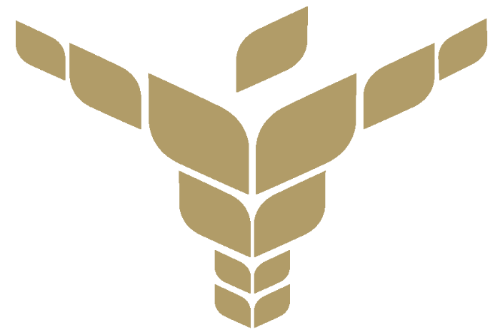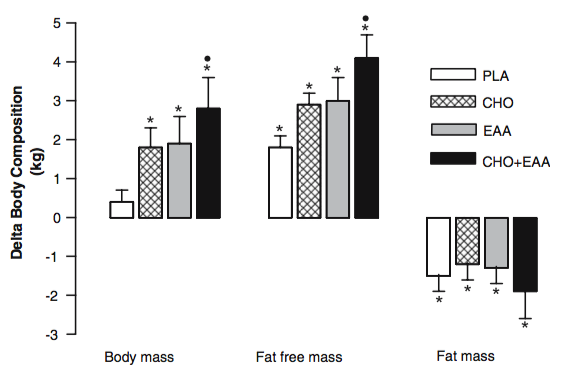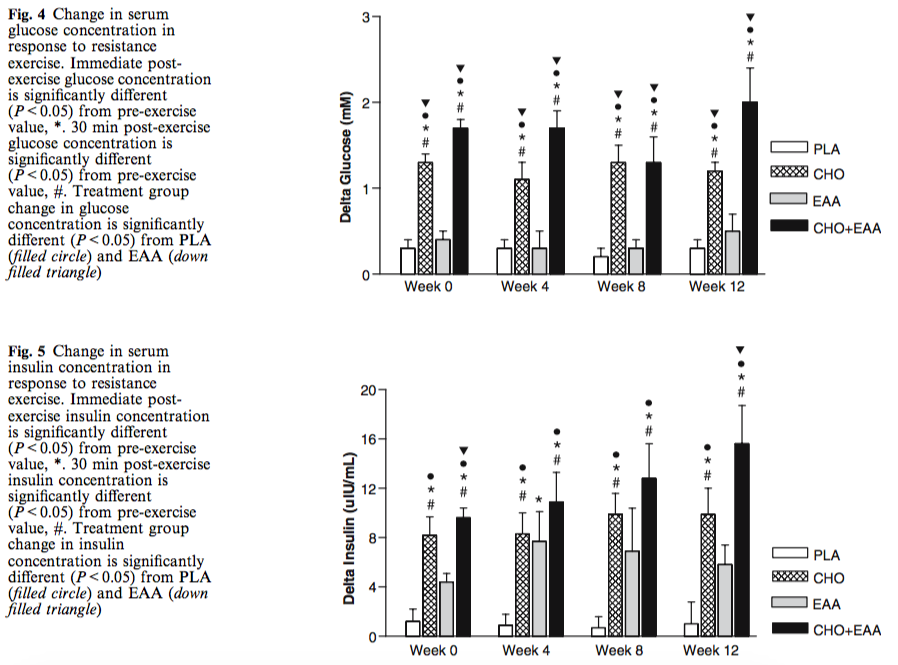1. Essential Amino Acid’s (EAA’s) are better than Branched Chain Amino Acid’s (BCAA’s).
When it comes to making gains you want the full amino acid profile because it has been found that loading up on Leucine, Isoleucine and Valine can have a negative effect on neurotransmitter balance effecting drive and recovery. BCAA’s lack essential amino acids like L-Tryptophan and L-Tyrosine (precursors to dopamine and serotonin) which can throw off neurotransmitter balance over time. Also, net protein utilization are profoundly affected by the limitations of the complete amino acid profile, therefore it is important to have all essential amino acids present to make optimal gains.
2. Essential Amino Acid’s (EAA’s) combined with a Carbohydrate source are best for making strength and hypertrophy gains.
A 2006 study called “Independent and Combined Effects of Liquid Carbohydrate/Essential Amino Acid Ingestion on Hormonal and Muscular Adaptations following Resistance Training in Untrained Men” showed surprising results in that Carbohydrates alone outperformed EAA’s in almost all categories including, Muscle Fiber (Type I, Type IIa and Type IIb) improvements; Post-Workout Glucose Uptake, Insulin response and favorable reduction in Cortisol response. Yet, when EAA’s were combined with Carbohydrates for intra-workout nutrition, the positive effects on all categories were greater than either EAA’s or Carbohydrates alone. The best results for Body Composition were also seen in the EAA/Carb group. Moral of the story, to optimize your workout use EAA’s and Carbohydrates together.
3. The more carbohydrate sources you take in before/during/after your workout the better the absorption rate.
Your body can absorb 1g of carbohydrates from a single source from dextrose, maltodextrin, fructose, cluster dextrine, etc. per minute. However, if you combine sources you can increase carbohydrate uptake into the muscle by a factor of 5. Products like PentaCarb are formulated for this specific purpose and as the name implies, it has five different carbohydrate sources.
4. Improve insulin sensitivity for optimal hypertrophy.
The easiest way to recognize that you are not insulin sensitive is that you do not feel the “pump” when you are working out. The more insulin sensitive you are the better able you are to increase glucose and amino acid uptake into the muscle cells, thereby suppressing cortisol and reducing muscle breakdown. Plus, if you are insulin sensitive, when you eat carbohydrates the are better able to be used for fueling your muscles rather than storing them as fat.
5. Don’t have a bolus dose of Antioxidants around your workout.
This can turn off your insulin sensitivity and reduce the amount of hormetic stress placed on your mitochondrial which are both drivers of growth.
6. Fasting is beneficial, even for those seeking hypertrophy.
Due to the amount of calories one must consume to put on size, the gut can take quite a beating. Fasting allows the gastrointestinal tract to relax and have time to heal so that when the fast is over, nutrients can be better absorbed. A 24 hour fast once a week can offer improvements. Also, intermittent fasting for 3 days a week has the same benefits as intermittent fasting for 7 days a week.
7. Over 90% of athletes are deficient in Iodine.
This fundamental nutrient is often lost through sweat and can cause hydrochloric acid (stomach acid) deficiencies, migraines, insomnia or brain fog if not repleted through supplemental or dietary means.
8. When it comes to nutrition, the 80/20 Rule is Bullshit.
You have to take into account the inflammatory affects of food and the cumulative effect it can have on your body. A study recently produced a study that said 100% of people who consume gluten have intestinal inflammation within 30 minutes!
9. The first step towards success is taken when you refuse to be a captive of the environment in which you first found yourself.
This is the basis of all change, and fundamental to my 7 Pillars of Health. Realizing that the environment that surrounds you makes you who you are; the people, the food, the job, the situation all have an effect, whether good or bad. To make a change, start by changing your environment.
10. The things that are done to you or for you are rarely as effective as the things you do for yourself.
Read that over a few times.
















